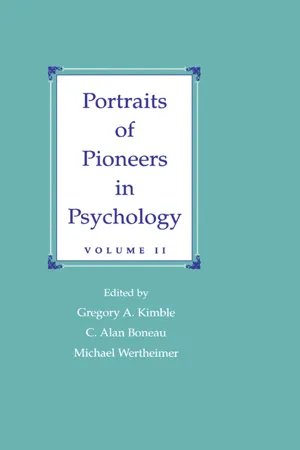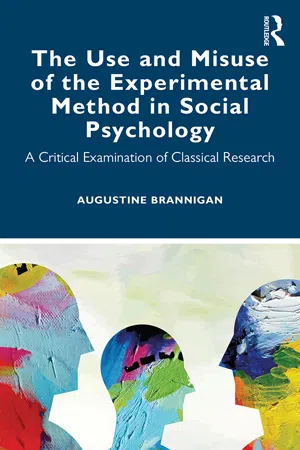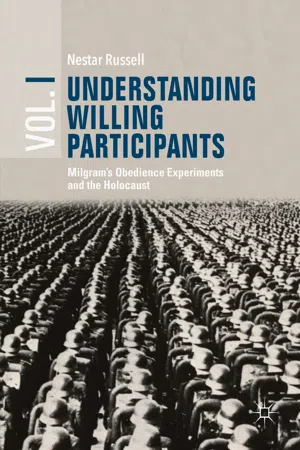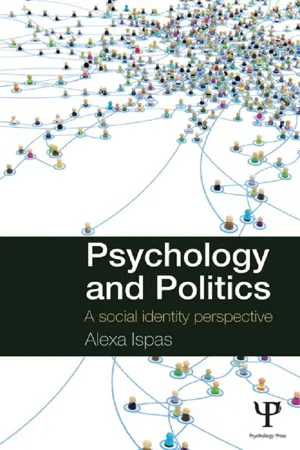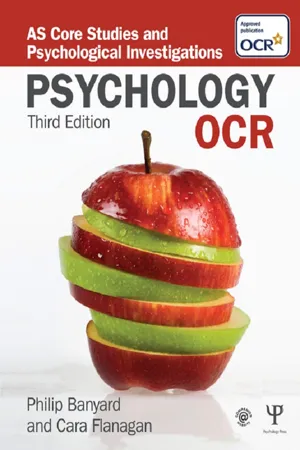Psychology
Stanley Milgram
Stanley Milgram was a social psychologist known for his controversial obedience experiments. In the 1960s, he conducted a series of studies at Yale University to investigate the willingness of participants to obey authority figures, even when it involved inflicting harm on others. The findings raised ethical concerns and sparked discussions about the power of authority and ethical considerations in research.
Written by Perlego with AI-assistance
Related key terms
10 Key excerpts on "Stanley Milgram"
- eBook - ePub
Obedience to Authority
Current Perspectives on the Milgram Paradigm
- Thomas Blass, Thomas Blass(Authors)
- 1999(Publication Date)
- Psychology Press(Publisher)
2How Stanley Milgram Taught About Obedience and Social Influence
Harold TakooshianFordham University“What was he like?” This is the question almost invariably heard by a few dozen U.S. social psychologists, when someone discovers they studied with Stanley Milgram. Such curiosity is understandable, considering that Milgram was such a widely-known researcher who taught so few students, and that only a small number of psychologists knew Milgram as anything but the larger-than-life scientist who created the obedience experiments. “What was he like?” is indeed an excellent question, because those of us who studied with Milgram saw much more than a researcher. As a doctoral student in the Social-Personality Psychology program at the graduate school of the City University of New York (CUNY), I completed some half-dozen of Milgram’s courses, and he chaired my dissertation committee. This chapter cumulates my recollections, supplemented by those of some of his other students, to describe Milgram’s work in the classroom—his teaching in general, and his teaching about obedience and social influence in particular.Stanley Milgram, PROFESSOR
There is no question of Stanley Milgram’s pre-eminence as a behavioral researcher (Blass, 1992, 1996), the architect of “the most well-known research in social psychology, perhaps all of psychology” (Brock & Brannon, 1994, p. 259). An introductory psychology textbook would be incomplete without mention of Milgram’s obedience experiments (Perlman, 1980). A social psychology course without them would be unthinkable (Perlman, 1979). Some prominent social psychologists have been unreserved in recognizing a unique quality in Milgram’s obedience research, that applies to no other study within the field. For example, Muzafer Sherif (1975) said, “Milgram’s obedience experiment is the single greatest contribution to human knowledge ever made by the field of social psychology, perhaps psychology in general.” And at Milgram’s eulogy in December, 1984, his close colleague Irwin Katz noted “When viewed in relation to the main body of psychology…, Stanley Milgram’s work on obedience stands by itself—an indestructible monolith on an uninhabited plain.” Besides the obedience studies, which he conducted in his twenties, he went on to do other pioneering research on city life, the media, cognitive maps, and a score of diverse topics (Blass, 1992), that made him one of the few social scientists to directly impact our popular culture—including Broadway theater and feature films (Takooshian, 1998), and a television play based on the obedience experiments (Milgram, 1976). - eBook - ePub
Great Ideas in Psychology
A Cultural and Historical Introduction
- Fathali M. Moghaddam(Author)
- 2013(Publication Date)
- Oneworld Publications(Publisher)
2 Imagine living in the seventeenth century rather than the twenty-first century. What are some ways in which you would experience less individual rights and be expected to show greater obedience to authority?THE EXPERIMENTAL STUDY OF OBEDIENCE
Before 1960, two ground-breaking series of studies on conformity were conducted by psychologists, the first initiated by Muzafer Sherif in the 1930s and the second by Solomon Asch in the 1950s. Both of these series of studies were conducted in contexts involving issues that had little real-world significance: estimating the movement of a spot of light (in the case of Sherif’s studies) and estimating lengths of lines (in the case of Asch’s studies). During 1959–60 Stanley Milgram was working in Asch’s laboratory and thinking about what would happen if instead of the movement of a spot of light, judgments of line lengths, or the like, issues of greater human significance were introduced into the laboratory. Would the individual still bend to the will of the majority? This question was the point of departure for Milgram’s studies on obedience to authority, and it eventually led to the question of how far individuals would obey an authority figure.Milgram recruited participants by advertising for volunteers aged 20–50 to take part in a study on the effect of punishment on learning. Participants were told that a goal of the research was to discover how much punishment is good for learning, how much difference it makes whether an older or younger person is giving the punishment, and similar such questions. From the pool of applicants he was able to select a sample of participants with varied ages and backgrounds. In each experiment, the participants were forty percent skilled and unskilled workers, forty percent white-collar, sales, and business, and twenty percent professionals. All those selected had been screened to ensure that they had a normal psychological profile. When the selected participants arrived at Milgram’s laboratory, they were introduced to another person who was supposedly also a participant but was actually a middle-aged accountant selected to act as Milgram’s confederate. It was explained to the participants that this learning experiment required a teacher and a student. The two participants drew lots to decide who would play the role of the teacher and who would play the role of the student, but the outcome was pre-arranged so that the confederate would always play the role of student. There was also a scientist in a white laboratory coat in the room, purportedly in charge of the “learning study.” - eBook - ePub
Portraits of Pioneers in Psychology
Volume II
- Gregory A. Kimble, C. Alan Boneau, Michael Wertheimer(Authors)
- 2012(Publication Date)
- Psychology Press(Publisher)
American Psychologist in 1964 (Baumrind, 1964; Milgram, 1964).And so it was, during the Harvard years, that Milgram became the focus of a storm of controversy, as he and his work became widely known to the academic community as well as to the public through newspaper and magazine articles. He was in much demand as a colloquium speaker, his journal articles would eventually be reprinted in dozens of anthologies, and clergymen, in their sermons, drew moral lessons from his work. Over the years, many people wrote to him to ask about details of the experiments, and he would readily provide them. Some of these letters tied Milgram’s studies to the personal lives of their authors with a surprising degree of candor. For example, one man wrote that he had read about the obedience experiments and found them interesting but limited, because the victim was an actor—not a person really getting hurt. This letter writer, on the other hand, had real victims in his work: He was an employee of the local electric company whose job was to turn off power to the homes of delinquent customers, even when the temperature dropped to below-freezing levels.It was also at Harvard that Stanley experienced one of the greatest disappointments of his life: He was not offered tenure, although he was considered for it. Roger Brown, who was a colleague in the Department of Social Relations at the time, attributes the university’s decision not to offer tenure to the opposition of a few senior members of the department, opposition he said was based on nonrational considerations. Specifically, Brown told me that some people “attributed to him some of the properties of the experiment. That is, they thought he was sort of manipulative, or the mad doctor, or something of this sort. … They felt uneasy about him.” Brown believed that characterization to be unfounded and said that he “felt closer to him than to almost any psychologist in my lifetime” (Brown, K. personal communication, June 23, 1993). - eBook - ePub
Stanley Milgram
Understanding Obedience and its Implications
- Peter Lunt(Author)
- 2009(Publication Date)
- Bloomsbury Academic(Publisher)
2 Milgram’s Explanation of His FindingsThe experiments that Milgram conducted are fascinating in their own right and the results raise important and worrying questions about human agency and responsibility in the face of authority. However, what motivated Milgram to conduct these experiments and how did he interpret the results? In his book Obedience to Authority , written ten years after he had completed his experiments, Milgram was able to develop a psychological theory of the results, to reflect on the ideas that had influenced him and to elaborate on the broader social, political and moral context of his research.In the preface and first chapter of Obedience to Authority Milgram reviews the theoretical questions and social concerns that led him to design and conduct his obedience experiments. Milgram does not start with psychological theory but blends sociological analyses of power and authority with enduring concerns about the Holocaust and political concerns about post-war American society. Milgram’s acknowledgements give us some clues as to the key influences on his work. The list of authors he cites are from two different academic traditions: research on the social psychology of social influence, including Asch, Lewin and Sherif and a group of writers of social and political theory who influenced the broader intellectual zeitgeist in which Milgram and other social scientists of his day started their careers, including Adorno et al. (1950), Arendt, Fromm and Weber.Milgram starts his discussion with a paradox which he claims is as old as western civilisation; that authority and obedience are necessary for the cohesion and smooth running of society and therefore of tremendous benefit. At the same time, however, under the influence of authority individuals can perform acts that they would otherwise regard as wrong, immoral or evil. This is an important starting point because it suggests that obedience as a basic function of complex societies can be used for both positive and negative ends, and is therefore value neutral. Although Milgram is interested in sociological and political questions, he places the individual at the centre of his enquiry. When an authority figure asks an individual to do something they disagree with there is a conflict between the individual and society. Milgram sees obedience to authority through the eyes of a social psychologist who is concerned with the relationship between individuals and society. - eBook - ePub
The Use and Misuse of the Experimental Method in Social Psychology
A Critical Examination of Classical Research
- Augustine Brannigan(Author)
- 2020(Publication Date)
- Routledge(Publisher)
4 Scientific demonstration in Milgram, Zimbardo, and RosenhanMore evidence from the archivesIntroduction
In this chapter, we focus on three of the most provocative studies in classical social psychology: Stanley Milgram’s obedience study, Philip Zimbardo’s Stanford Prison Experiment, and David Rosenhan’s study of psychiatric hospitals. The theme that unites these diverse investigations is the utilization of the experiment as a pedagogical device to demonstrate a perspective whose findings are a foregone conclusion.The Holocaust and obedience to authority
Although Milgram’s study was derived conceptually from the work of Solomon Asch (Sabini 1986), the trial of Adolph Eichmann sharpened the issues for him. Eichmann was the allegedly plodding Nazi bureaucrat who assisted in the mass murder of European Jewry by masterminding the concentration of the victims in Poland after the Nazi occupation of France and most of western Europe. Subsequently, the Nazis developed factories for the extermination of Jewish victims at Treblinka, Sorbibor, Auschwitz, and other death camps. Several million innocent people, men, women, and children, were murdered at these death camps by ordinary German administrators, policemen, soldiers, and camp guards. In Milgram’s experiment, ordinary subjects were cast in the parts of executioners. In the “received view” of this work (Stam, Radtke, and Lubek 1998), Milgram took people from all walks of life and turned them into the experimental analogs of Eichmann, suggesting that the capacity for evil was fostered in virtuous individuals by monstrous bureaucrats. The existential problem could not have been more clear-cut. Indeed, all of Milgram’s work has the bite of immediate relevance.The study was advertised as an experiment designed to test the effects of punishment on human learning. Subjects (“teachers”) were paid to teach the “learners” to memorize a long series of paired associations. The pretext for the study was to advance knowledge about the effectiveness of negative reinforcements on learning. Errors were to result in a shock, but the level of the shock escalated at every mistake in fifteen-point gradations from 15 volts right up to and beyond 450 volts. The experiment was run with individual teachers and learners, but the role assignment was rigged so that the real subject was always assigned the role of the teacher who administered shocks, while an affable middle-aged man, a confederate, acted as the learner. The teachers were given a sample shock to demonstrate the actual discomfort that resulted from their control of the shock machine. The machine was an impressive electrical appliance with switches, lights, and verbal designations describing the severity of the shock (mild, moderate, high, extremely high, XXX). The subjects were drawn from a wide range of occupations and professions, unlike the usual captive population of undergraduate students. - eBook - ePub
Psychoanalysis, Classic Social Psychology and Moral Living
Let the Conversation Begin
- Paul Marcus(Author)
- 2019(Publication Date)
- Routledge(Publisher)
banality of evil comes closer to the truth than one might dare imagine. The ordinary person who shocked the victim did so out of a sense of obligation—a conception of his duties as a subject—and not from any particular aggressive tendencies. This is, perhaps, the most fundamental lesson of our study: ordinary people, simply doing their jobs, and without any particular hostility on their part, can become agents in a terrible destructive process.(Milgram, 1974, pp. 5–6)It is mainly within the psychosocial context of trying to fathom the Holocaust that Milgram designed a series of obedience to authority experiments that provided “evidence of probably the most compelling phenomenon ever uncovered by social psychology” (Reicher & Haslam, 2017, p. 125). Indeed, researchers and scholars are still debating Milgram’s fifty-year-old findings and analyses, though the obedience to authority phenomenon “still lacks a compelling explanation” (ibid.).The obedience shock experiments
In Experiment 5, the most famous of the eighteen variations, Milgram informed naïve subjects in the all-males study that they were engaged in a scientific investigation of the effects of punishment on learning [all were “decent and courteous” in real-life says Milgram (1974, p. 132)]. One of the men in each participant pair would act as the “Learner” and would attempt to do a simple task involving memory by supplying a word. The other man was the “Teacher” who was requested to read the words to the Learner and would punish mistakes through an electric shock if the Learner did not provide the second word in each pair. The shocks were delivered by an imposing, realistic-looking machine (henceforth, the shock generator) that contained thirty numbered switches spanning from 15 volts (“slight shock”) through 450 volts (“XXX”; the descriptor for 375 volts read, “danger severe shock”), reflecting the first to the thirtieth switch. The two participants involved in the study, the naïve subject (the Teacher) and a research assistant (the Learner) then drew slips of paper from a hat to decide who would assume each role. The drawing was rigged so that the naïve subject always assumed the role of the Teacher. The Teacher was then instructed by the scientific-looking authority in a white coat to give a shock to the Learner whenever he made an error on the memory task. Most importantly, the Teacher was instructed that they had to increase the strength of the shock each time the Learner made a mistake. What this meant was that when the Learner made numerous mistakes, he would soon be getting strong and seemingly painful jolts of electricity. It is vital to understand that the Learner, who was actually a research assistant, never received any shocks during the experiment. The only time a shock was ever used was a mild pulse from switch number three to persuade naïve subjects that the shock generator was in fact real. - eBook - ePub
Understanding Willing Participants, Volume 1
Milgram's Obedience Experiments and the Holocaust
- Nestar Russell(Author)
- 2018(Publication Date)
- Palgrave Macmillan(Publisher)
© The Author(s) 2018 Nestar Russell Understanding Willing Participants, Volume 1 https://doi.org/10.1007/978-3-319-95816-3_3Begin Abstract3. The Origins and Evolution of Milgram’s Obedience to Authority Experiments
End AbstractNestar Russell1(1) University of Calgary, Calgary, AB, CanadaIt is not unusual for scholars largely critical of the Obedience studies to nevertheless admit to being impressed by aspects of Milgram’s work. Marcus , for example, after writing a largely negative review of Milgram’s book concluded that the experiments were “devilishly ingenious, cleverly thought out, and—whatever one thinks of them—extremely provocative and probably important.”1How, exactly, did Milgram come up with a research idea that, as Blass argues, “is clearly one of the best-known psychological experiments of our time”?2This chapter reveals the key influential events, experiences, and people that contributed to Milgram’s development of the Obedience studies. These influences were many and varied, and the earliest of them to date Milgram’s early childhood . They are worth reviewing because Milgram’s journey of discovery is likely to have influenced the theoretical development of his project and help us to better understanding how during the Holocaust ordinary and only moderately antisemitic Germans so quickly became willing executioners.Beginnings and Early Influences
Several months after the Nazi regime came to power, Stanley Milgram was born into a working-class Jewish family in the Bronx on 15 August 1933. Milgram’s Hungarian father and Romanian mother maintained a small, yet successful bakery and cake-decorating business. From an early age, he showed a keen interest in a wide variety of scientific pursuits ranging from mixing sometimes explosive chemical concoctions to, at age 15, designing a dual-jet-propelled crankshaft.3Young Milgram was bright, imaginative, and curious. As he said himself, “I was always doing experiments; it was as natural as breathing, and I tried to understand how everything worked.”4However, life was not without its somber overtones. Throughout Milgram’s childhood, his parents worried constantly about the fate of relatives in Europe caught under the cloud of the expanding Nazi empire.5Stanley’s awareness of, and sensitivity to, the geographically distant persecution of European Jews extended into his formative years, as his 1946 Bar Mitzvah speech makes clear.As I come of age and find happiness in joining the rank[s] of Israel, the knowledge of the tragic suffering of my fellow Jews throughout war-torn Europe makes this also a solemn event and an occasion to reflect upon the heritage of my people—which now becomes mine.6 - eBook - ePub
Psychology and Politics
A Social Identity Perspective
- Alexa Ispas(Author)
- 2012(Publication Date)
- Psychology Press(Publisher)
5
The psychology of authoritarian regimes
Learning objectives
• gain a critical understanding of Milgram's obedience studies and Zimbardo's Stanford prison experiment, and their implications for resisting authoritarian regimes; • develop an insight into the process through which authoritarian regimes gain access to power; • recognize the dynamics of resistance in political settings.In the previous chapter, we touched on leaders’ ability to construct the social context in such a way as to bolster their prototypicality and therefore their social influence within the group. This aspect of leadership can be used just as effectively by leaders wishing to safeguard democratic processes as by leaders intent on using their social influence to impose authoritarian, tyrannical regimes.In this chapter we consider the psychological underpinnings of such regimes. We discuss two social psychological experiments that in different ways have influenced the public consensus on our ability to resist tyrannical systems: Milgram's obedience studies and Zimbardo's Stanford prison experiment. These studies are widely known outside the discipline and are often perceived as showing that human beings are helpless in the face of tyranny. The source of tyranny is located within an authority figure in the Milgram studies, or within ourselves in the case of Zimbardo's Stanford prison experiment. From a social identity perspective, this interpretation is problematic, and not supported by the data. In fact, when examining the findings with a focus on social identity, we discover that they can be interpreted more fruitfully in terms of our ability to withstand tyranny.Deference to authority: Milgram's obedience studies
Milgram's (1974) research on obedience constitutes one of the best-known social psychology experimental paradigms. This research was widely publicized through a short educational film titled Obedience - eBook - ePub
OCR Psychology
AS Core Studies and Psychological Investigations
- Philip Banyard(Author)
- 2013(Publication Date)
- Psychology Press(Publisher)
1964 ) wrote a damning critique, arguing that just because someone volunteers for a study this does not take away the researcher’s responsibilities towards them. She used direct quotes from Milgram’s study to illustrate the lack of regard she believed was given to the subjects. For example:‘In a large number of cases the degree of tension [in the subjects] reached extremes that are rarely seen in sociopsychological laboratory studies. Subjects were observed to sweat, tremble, stutter, bite their lips, groan, and dig their fingernails into their flesh. These were characteristic rather than exceptional responses to the experiment.’ (page 375)Baumrind accepted that some harm to subjects is a necessary part of research, for example testing out new medical procedures, because the results could not be achieved in any other way. Social psychology, however, is not in the same game as medicine and is unlikely to produce life-saving results, thus does not justify harming subjects.The case for the prosecution was very powerful. Milgram’s application to join the American Psychological Association (APA) was put on hold while they investigated the study, and he was not given the post he hoped for at Yale.The case for the defence, however, is overwhelming. At the time of study psychologists were less sensitive about ethical issues than today, however there were ethical guidelines in place. In fact Milgram took more care than his colleagues about such issues. His obedience study contains the first reference to debriefing - eBook - ePub
- Zygmunt Bauman(Author)
- 2013(Publication Date)
- Polity(Publisher)
2 The fashion in which Adorno and his team articulated the problem was important not so much because of the way in which the blame was apportioned, but because of the bluntness with which all the rest of mankind was absolved. Adorno’s vision divided the world into born proto-Nazis and their victims. The dark and dismal knowledge that many gentle people may turn cruel if given a chance was suppressed. The suspicion that even the victims may lose a good deal of their humanity on the road to perdition, was banned – the tacit prohibition which stretched to the extremes of absurdity in the American television portrayal of the Holocaust.It was such academic tradition and this public opinion, both deeply entrenched, heavily fortified and mutually reinforcing, that Milgram’s research challenged. A particular disquiet and rage were caused by his hypothesis that cruelty is not committed by cruel individuals, but by ordinary men and women trying to acquit themselves well of their ordinary duties; and his findings, that while cruelty correlates but poorly with the personal characteristics of its perpetrators, it correlates very strongly indeed with the relationship of authority and subordination, with our normal, daily encountered, structure of power and obedience. ‘The person who, with inner conviction, loathes stealing, killing, and assault, may find himself performing these acts with relative ease when commanded by authority. Behaviour that is unthinkable in an individual who is acting on his own may be executed without hesitation when carried out under orders.3
Learn about this page
Index pages curate the most relevant extracts from our library of academic textbooks. They’ve been created using an in-house natural language model (NLM), each adding context and meaning to key research topics.


